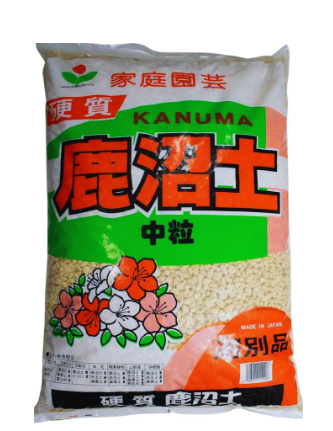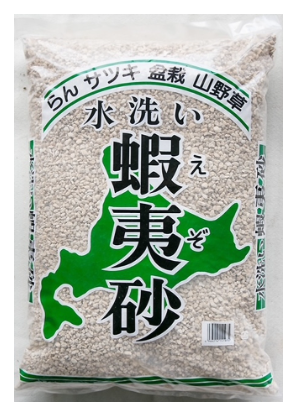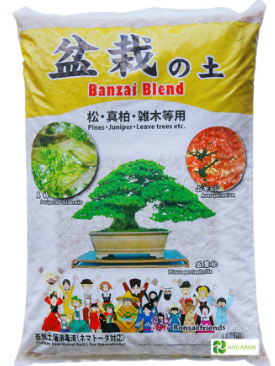The Complete Guide to Bonsai Soil: Choosing the Right Mix for Healthy Growth
Posted by Angel O. on Jul 21st 2025
If you want your bonsai tree to grow healthy and strong, it all begins with the soil. While pruning and shaping are essential for style, the real health of your tree depends on what is happening below the surface. The roots need the right environment to breathe, absorb moisture, and expand properly.
At Hagabon, we carry a carefully curated range of bonsai soils, each selected for its quality, drainage ability, and support for healthy root systems. In this guide, you will learn everything about the soil types we offer and how to choose the right one for your tree.
Why Bonsai Trees Need Special Soil
Bonsai trees grow in shallow pots with very limited space for their roots to expand. Because of that, the soil must do more than support the tree physically. It must drain excess water quickly while still holding enough moisture for the tree to thrive. It must also allow for airflow to prevent root rot and create the right structure to support delicate feeder roots.
Regular garden soil or potting mix is too dense. It holds too much water, compacts over time, and prevents air from reaching the roots. This is why bonsai soil must be different. Every soil at Hagabon is selected to solve these problems and give your tree the environment it needs to grow.
A Closer Look at Bonsai Soil Options from Hagabon
Let’s explore each of the bonsai soils available at Hagabon. Every product is unique and serves a specific purpose, depending on the type of tree and your growing conditions.
Japanese Akadama Soil
Available in extra small, small, and medium grain
Prices range from $23 - $25
Akadama is a hard-fired clay imported from Japan. It is widely considered the most essential ingredient in bonsai soil. It retains moisture while offering excellent drainage and slowly breaks down over time, improving root contact and soil structure. One of its best features is the color change that helps you see when the soil is dry or wet.
Best used for trees like maples, junipers, ficus, pines, and most common bonsai species.
Akadama can be used on its own or mixed with pumice and lava rock for a custom blend.

Kanuma Bonsai Soil
Available in small and medium grain
Price is $21
Kanuma is a soft volcanic soil known for its naturally acidic pH. It is commonly used for flowering bonsai species that need more acidic soil conditions. Kanuma is lighter and more moisture-retentive than Akadama. Its soft texture supports delicate roots and reduces transplant stress.
Ideal for azaleas, camellias, and gardenias
Works well on its own or blended with pumice to adjust structure

Ezo Pumice Soil
Available in small and medium grain
Price is $21
Pumice is a porous volcanic rock that is excellent for drainage. It allows water to move freely through the soil while still holding enough moisture for the roots to absorb. It also prevents the soil from becoming compacted. Pumice does not break down over time, making it an excellent choice for maintaining structure between repottings.
Ideal for pines, olives, boxwoods, and any bonsai that needs good drainage
Perfect for blending with Akadama and Kanuma to reduce moisture retention

Japanese Bonsai Soil Blend
Available in extra small and small grain
Price is $31
This pre-mixed blend of Akadama, pumice, and lava rock is perfect for growers who want a ready-to-use solution. It balances moisture retention, drainage, and aeration without needing extra mixing or measuring. The blend is also suitable for a wide variety of species, especially for beginners.
Best for everyday care and maintenance of small to medium bonsai
Ideal for first-time bonsai owners who want a reliable, balanced soil

Professional Bonsai Soil
Comes in a 12-quart bulk bag
Price is $79, discounted from $99
This professional-grade mix includes 25 percent Akadama, 25 percent pumice, 25 percent crushed lava, and 25 percent pine bark. It is designed for mature trees or serious growers who need a long-lasting, nutrient-rich soil. The pine bark adds organic matter, supporting microbial life and steady nutrient release.
Great for large bonsai collections or older trees with advanced care needs
Supports long-term root development and excellent drainage
When to Repot Using Hagabon Soil
Even high-quality soil needs to be refreshed every one to three years. Repotting helps prevent compaction, gives roots space to grow, and allows you to inspect and clean the root system.
Signs that your bonsai needs repotting include
- Roots circling around the pot
- Water pooling on the surface or draining too slowly
- Soil feels hard or compacted
- Tree growth has slowed or appears weak
Use fresh Hagabon soil along with mesh screens and root tools for a smooth repotting process. The right tools and soil can reduce stress on your tree and set it up for stronger growth.
Which Soil is Right for Your Tree
Here’s a quick comparison of the different bonsai soil types available at Hagabon
| Soil Type | Texture | Moisture Level | Best For | Key Benefit |
|---|---|---|---|---|
| Akadama | Hard clay | Moderate | Maples, junipers, ficus | Balanced and versatile |
| Kanuma | Soft volcanic | High | Azaleas and flowering trees | Acidic and gentle on roots |
| Ezo Pumice | Porous rock | Low to moderate | Pines, olives | Improves drainage and airflow |
| Soil Blend | Mixed materials | Balanced | Beginners and most species | Ready to use with no mixing |
| Pro Soil | Inorganic and organic mix | Balanced and nutrient-rich | Mature trees and advanced growers | Long-term support and nutrition |
Shop Bonsai Soil and Tools at Hagabon
At Hagabon, we believe the right soil can make all the difference. Every product in our collection is chosen to support the health, longevity, and beauty of your bonsai tree. Whether you are shaping your very first tree or repotting a prized specimen, we have the soil and tools to support your journey.
Browse All Bonsai Soil
Explore Bonsai Tools
Healthy roots create beautiful trees. Build that foundation with the best bonsai soil from Hagabon.

